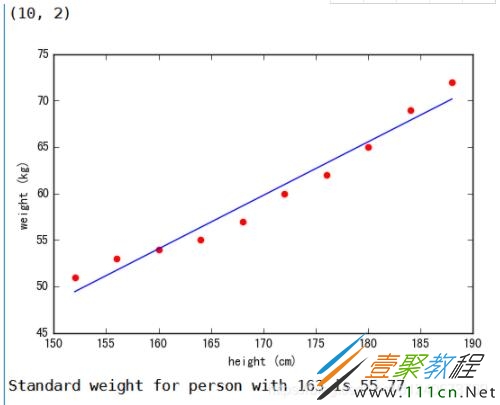python如何实现线性回归算法 python实现线性回归算法代码示例
作者:袖梨
2022-06-25
python如何实现线性回归算法?本篇文章小编给大家分享一下python实现线性回归算法代码示例,文章代码介绍的很详细,小编觉得挺不错的,现在分享给大家供大家参考,有需要的小伙伴们可以来看看。
代码如下:
# -*- coding: utf-8 -*-
"""
Created on Fri Oct 11 19:25:11 2019
"""
from sklearn import datasets, linear_model # 引用 sklearn库,主要为了使用其中的线性回归模块
# 创建数据集,把数据写入到numpy数组
import numpy as np # 引用numpy库,主要用来做科学计算
import matplotlib.pyplot as plt # 引用matplotlib库,主要用来画图
data = np.array([[152,51],[156,53],[160,54],[164,55],
[168,57],[172,60],[176,62],[180,65],
[184,69],[188,72]])
# 打印出数组的大小
print(data.shape)
# TODO 1. 实例化一个线性回归的模型
model=linear_model.LinearRegression()
# TODO 2. 在x,y上训练一个线性回归模型。 如果训练顺利,则regr会存储训练完成之后的结果模型
x,y=data[:,0].reshape(-1,1),data[:,1]
regr=model.fit(x,y)
# TODO 3. 画出身高与体重之间的关系
plt.scatter(x,y,color="red")
# 画出已训练好的线条
plt.plot(x, regr.predict(x), color='blue')
# 画x,y轴的标题
plt.xlabel('height (cm)')
plt.ylabel('weight (kg)')
plt.show() # 展示
# 利用已经训练好的模型去预测身高为163的人的体重
print ("Standard weight for person with 163 is %.2f"% regr.predict([[163]]))
相关文章
精彩推荐
-
 下载
下载摩托车销售模拟器内置菜单中文版
模拟经营 摩托车销售模拟器内置菜单中文版摩托车出售模拟器,又名摩托车销售模拟器,这是一个以摩托车销售
-
 下载
下载船舶模拟2020最新版
模拟经营 船舶模拟2020最新版船舶模拟2020是玩法非常有意思的模拟驾驶游戏,高清3d画质
-
 下载
下载油管主播的生活2内置菜单版
模拟经营 油管主播的生活2内置菜单版油管主播的生活2内置菜单版是一款模拟养成类游戏,在这里你将体
-
 下载
下载网吧老板模拟器2手机版
模拟经营 网吧老板模拟器2手机版网吧老板模拟器2是非常受欢迎的模拟经营题材手游,在原本的基础
-
 下载
下载美国警察模拟器巡警2024最新版
模拟经营 美国警察模拟器巡警2024最新版美国警察模拟器是一款好玩的模拟手游,游戏中你将扮演一位警察,
















